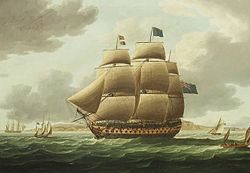HMS Ville de Paris
|
HMS Ville de Paris , painting by Thomas Buttersworth
|
||||||||||||||
|
||||||||||||||
|
||||||||||||||
|
||||||||||||||
|
||||||||||||||
The HMS Ville de Paris was a first class ship of the line of the Royal Navy with 110 cannons.
The ship was named after the French three-decker Ville de Paris , who had to drop the flag in the Battle of Les Saintes in 1782. During the transfer of the captured ships to Europe, the convoy got caught in a storm in September and two British and three captured ships of the line, including the Ville de Paris , were lost.
The HMS Ville de Paris was ordered on May 25, 1788, laid down on July 1, 1789 and launched on July 7, 1795 in Chatham . She served as the flagship of many admirals until 1815 . She did not take part in major sea battles. Shortly after its commissioning, it was rammed and damaged by the British triplane HMS Formidable on Christmas Day 1796 . In 1797 she followed HMS Victory as the flagship of the Mediterranean squadron. After 1799 she served as the flagship of the canal fleet . During this time she was the flagship of the cover squadron in the defense of A Coruña in the so-called Battle of La Coruña of 1808/09. Admiral Collingwood died on board the Ville de Paris in 1810 while she was lying in front of Mahon Station . In 1824 she was assigned as a hospital ship for port service and finally scrapped in 1845.
The Ville de Paris was the Royal Navy's first 110-gun ship and heralded a new stage in size development. It was first surpassed by the Hibernia in 1804 and then by the Caledonia in 1808 with 120 cannons each. The Hibernia was laid down in 1792 according to the same plans as the Ville de Paris in Plymouth. During construction, however, she was lengthened amidships by an 11 ft (approx. 3.30 m) long section and classified as a 120-gun ship when it was commissioned in 1804. It reached a new dimension in size and is said to have been a very successful construction. Decommissioned in 1855, it was not sold until 1902.
Individual evidence
- ↑ Helmut Pemsel : Sea rule. A maritime world history from the beginning to 1850. Weltbild-Verlag, Augsburg 1995, ISBN 3-89350-711-6 , p. 314.
- ^ A b Brian Lavery: The Ship of the Line. Volume 1: The development of the battlefleet, 1650-1850. 2003, p. 182.
- ^ A b David Lyon: The Sailing Navy List. All the Ships of the Royal Navy. Built, purchased and captured, 1688-1860. 1997, p. 105.
- ^ Robert Gardiner (Ed.): Nelson against Napoleon. From the Nile to Copenhagen. 1798-1801. Chatham Publishing et al., London 1997, ISBN 1-86176-026-4 , p. 117.
- ^ Richard Woodman : The Victory of Seapower. Winning the Napoleonic War, 1806-1814. Chatham Publishing, London 1998, ISBN 1-86176-038-8 , p. 163.
literature
- Brian Lavery: The Ship of the Line. Volume 1: The development of the battlefleet, 1650-1850. Conway Maritime Press, London 2003, ISBN 0-85177-252-8 .
- David Lyon: The Sailing Navy List. All the Ships of the Royal Navy. Built, purchased and captured, 1688-1860. Conway Maritime Press, London 1993, ISBN 0-85177-617-5 .
